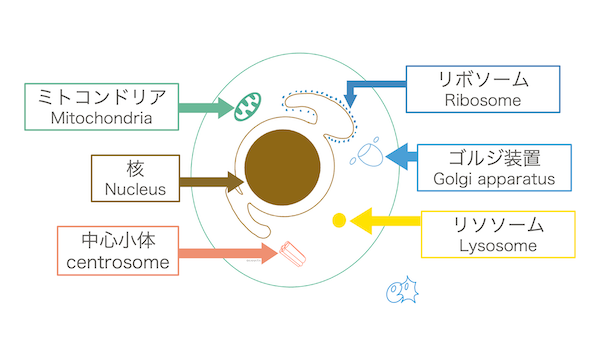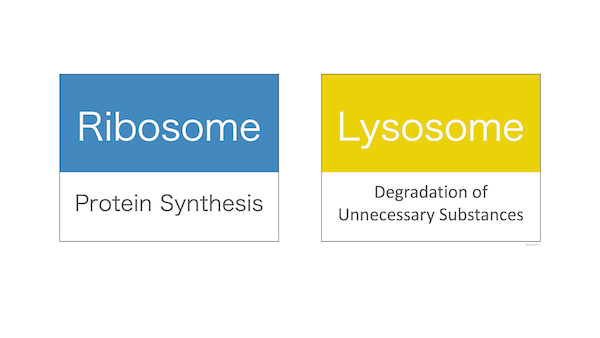Intracellular Organelles
Professor Neuko, please help me.
What's wrong, Cellnosuke?
I'm having trouble with memorizing intracellular organelles. There are too many things to remember, and I don't know where to start...
Indeed, it can be confusing with so many items to remember. Let's go through them one by one.
For this lecture, I want you to grasp the overall picture, so we won't delve into specific details.
Won't that make it more confusing?
No need to worry. I have organized the necessary information so that you can understand it by listening to today's lecture.
Now, let's begin the lecture.
Thank you, I appreciate it!
Intracellular Organelles
When it comes to understanding intracellular organelles, it's important to first grasp the key characters.
Key characters?
Yes, that's right. The key characters we'll be focusing on today are these six.

- 1st character: Nucleus
- 2nd character: Mitochondria
- 3rd character: Ribosomes
- 4th character: Golgi apparatus
- 5th character: Lysosomes
- 6th character: Centriole
That's a lot.
Don't worry, I'll summarize them as concisely as possible.
There is a lot to remember about intracellular organelles.
The first character is the nucleus. Just remember that it contains genetic information.
Is that all there is to know about the nucleus?
Talking about the nuclear membrane or nucleolus would make it longer.
Here, you just need to remember that the nucleus contains genetic information called chromosomes or chromatin.
Understood!
The nucleus contains genetic information.
The second character is mitochondria.
I've heard about it in muscle training magazines!
(So you're into muscle training...)
Mitochondria have fascinating stories, such as their symbiotic relationship with humans.
However, like the nucleus, talking about mitochondria in detail would make it lengthy.
Here, just remember that mitochondria generate ATP (adenosine triphosphate), which is essential for human movement.
Got it!
Mitochondria produce ATP (energy).
The third character is ribosomes.
I found it confusing when it comes to ribosomes attaching to the endoplasmic reticulum...
That's right. The detailed explanation involves the nuclear membrane and its connection to the endoplasmic reticulum, making it complex to understand.
So, just remember that ribosomes are responsible for protein synthesis.
Got it!
Ribosomes are involved in protein synthesis.
The fourth one is the Golgi apparatus, also known as the Golgi body.
It has a cool name.
Is that so? This one adds sugar chains, called markers, to the proteins synthesized by the ribosomes.
What happens when markers are added?
You can interpret the markers as addresses. They are attached to the proteins to send them to the required destinations, like putting addresses on them.
I see.
The Golgi apparatus adds sugar chains (markers) to proteins.
The fifth one is the Lysosome. It is also sometimes called the "Lisosome."
It sounds similar to the ribosome.
That's right. It even confuses me.
However, their functions are completely different. Lysosomes are responsible for breaking down and digesting unwanted substances within the cell.
So, they are like the cleaning crew.
That's right. Considering their similar names, it's best to associate their functions to remember them correctly.

Got it!
Lysosomes are the cleaning crew of the cell.
The fifth one is the Centriole. It works during cell division.
Cell division?
Have you ever wondered why the writings made with a permanent marker on your body disappear?
No, I haven't.
(This person doesn't get it.)
The skin cells undergo division and produce new cells. So, the reason the writings with a permanent marker disappear is that they are shed along with the old skin cells.
So, the new cells cover the body.
Exactly. It's not just the skin cells; most cells in the human body undergo cell division to generate new cells.
And the Centriole's job is to assist in the movement of chromosomes during cell division.
I see.
The Centriole works during cell division.
Now, let's summarize today's lesson.
Is that all?!
That's an important aspect of studying physiology. When you delve deeper, the subject becomes filled with complex terminology.
That's why it's crucial to start by organizing and understanding basic information.
Understood!
- Nucleus: Stores genetic information
- Mitochondria: Produces energy (ATP)
- Ribosome: Synthesizes proteins
- Golgi apparatus: Adds carbohydrate tags to newly synthesized proteins
- Lysosome: Acts as the cell's "cleaning crew"
- Centriole: Functions during cell division
First, try to remember the names and functions of these six entities.
Once you can recall them, your studying will progress smoothly.
Got it!
Start with the basics.
Well, that concludes today's lecture, even though it became quite lengthy.
Thank you very much!
Now, let's solve a few questions before we finish.
Nucleus
Produces energy (ATP).
Other correct answers include beta-oxidation and urea production.
Ribosome
Golgi apparatus
Lysosome
Centriole